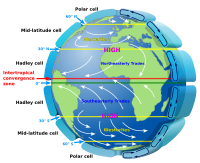
Photo from wikipedia
Few studies have estimated effects of weather on water intake in beef cattle, and most of these studies estimated effects during summer months. Our objective was to estimate effects of… Click to show full abstract
Few studies have estimated effects of weather on water intake in beef cattle, and most of these studies estimated effects during summer months. Our objective was to estimate effects of temperature, wind speed, and sunlight on daily water intake (DWI) of beef bulls in winter and early spring. Angus and SimAngus® bulls (n = 36; average starting BW = 369.5 ± 81.8 kg) were sampled from the South Dakota State University Cow-Calf Education and Research Facility (CCERF, Brookings, SD) from December 22, 2017 through April 5, 2018 (104 d total). Bulls were fed a diet (51.97% DM, 14% CP, and 1.08 Mcal NEg/kg DM) of high-moisture corn, corn silage, alfalfa hay, and supplement pellet. Individual feed and water intake were measured with an Insentec RIC system (Hokofarm, Marknesse, The Netherlands). Weather data, including average temperature, wind speed, and solar radiation were obtained from a Mesonet station located 3.9 km from the CCERF. Body weights were collected before feeding at four time points: December 13-14 (averaged), January 23, February 20, and April 2. Average daily gain was calculated from BW and used to predict BW on each day of the trial. Daily water and feed intakes were summed across all bulls each day; total DWI for all 36 bulls was the dependent variable. Average DWI per bull was 17.8 ± 7.05 kg/d and average total DWI per bull (including feed) was 28.9 ± 10.1 kg/d. Effects of average temperature, wind speed, and solar radiation were estimated with a linear model including a covariate of ADFI as percent predicted BW. Increased average temperature (P < 0.001) and solar radiation (P = 0.032) were associated with increased DWI, while increased average wind speed was associated with decreased DWI (P = 0.009). Temperature, wind speed, and amount of sunlight were associated with water intake of beef bulls fed from December until early April in Eastern South Dakota.
Journal Title: Journal of Animal Science
Year Published: 2019
Link to full text (if available)
Share on Social Media: Sign Up to like & get
recommendations!